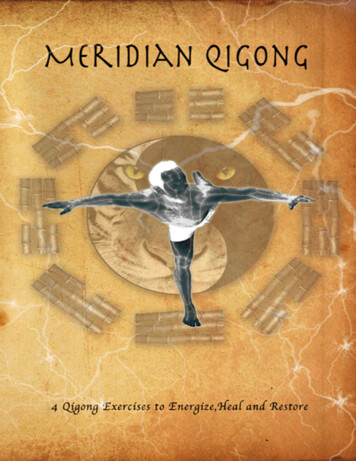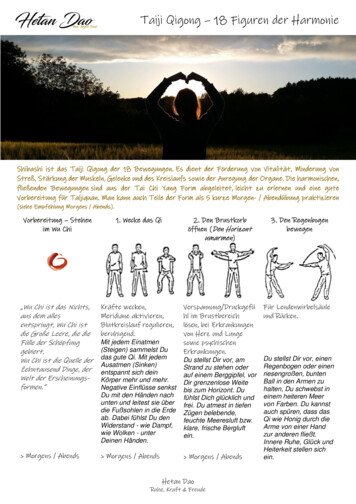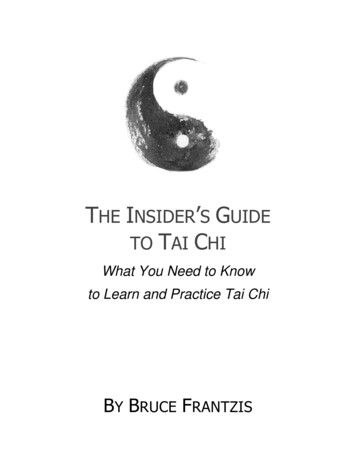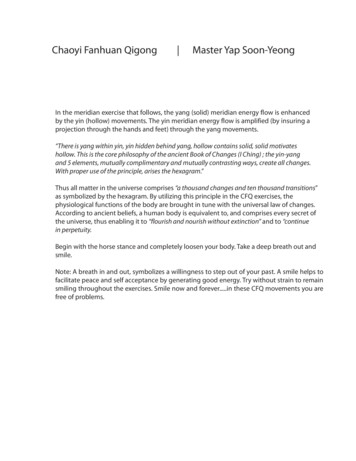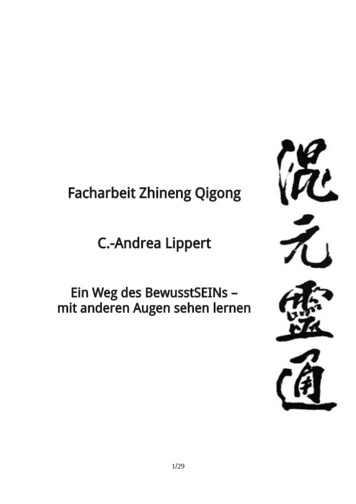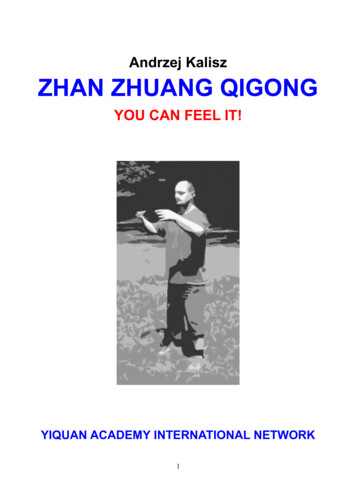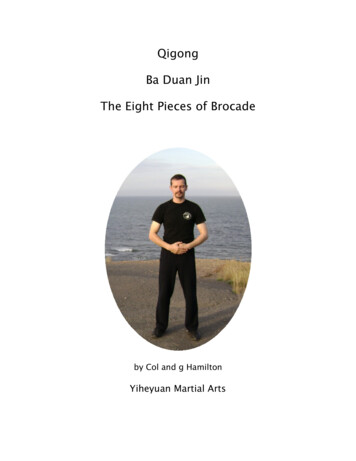
Transcription
QigongBa Duan JinThe Eight Pieces of Brocadeby Col and g HamiltonYiheyuan Martial Arts
ContentsPageIntroduction2Preparation21. Hold up the Sky32. The Archer43. Join Heaven and Earth54a. Turn and Look Over the Shoulder54b. Variation: Turn and Gaze at the Moon65a. Rotate the Body and Sink65b. Variation: The Ferris Wheel65c. Variation: Lean to the Side66. Punch with Fists77. Lift the Heels and Shake the Kidneys78a. Circle the Arms Forwards (Row the Boat)88b. Variation: Bend Forwards to Press the Earth8Gather the Energy and Return to the Tao9 C and g Hamilton Yiheyuan Martial Arts 2009Page 1
IntroductionThe Eight Brocade is an ancient qigong set and over the centuries many different variationsand interpretations have been developed. When practiced carefully and slowly, they can helpto improve and maintain health and well-being.The movements are demonstrated by Colin on a video clip. This set of notes is intended toaccompany the video as supporting information to assist with your practice and explain someof the health benefits you may expect. It is not, in itself, a detailed “how to” guide.You are advised to practice only those movements which are suitable for your own needs andcapabilities. Please consult your doctor before attempting them if you are unsure.Preparation – Rest in Wu ChiBefore starting a qigong sequence, rest in Wu Chi – the silence and stillnessunderlying everything – and allow the attention to settle into the dantien,the centre of the lower abdomen, about an inch below the navel.Gather Energy into the DantienCircle the arms three times, as if gathering up energy from the universe andshowering it down through the body; washing away any aches and pains andtensions, any negative thoughts and feelings, and releasing them outthrough the soles of the feet and into the earth. You can then imagine newpositive energy calming the mind, healing the heart and being stored in thedantien, ready for your use. C and g Hamilton Yiheyuan Martial Arts 2009Page 2
1 Hold up the skyStand with your back straight and your bodyrelaxed and upright.Breathe in as the hands are raised, palmsupwards, past the dantien and breathe out asyou push the palms up towards the sky, andthen slowly inhale as the hands come back down, on either side of the centre line, followingtwo of the body’s main energy channels or “meridians”.How far you can reach comfortably will depend on your own individual capabilities, so don’tworry if at first you can only raise your hands level with your forehead or nose or chin. Aswith all of these qigong exercises, your body needs time to adjust to new ways of moving,rather than be forced to exceed its limits. Regular gentle practice, over a period of a fewweeks, can be expected to yield much better results than an occasional strenuous session.As a variation of this exercise, you can bring the arms down by the sides,forming a circle as they are lowered.These movements can help to improve posture by stretching and straightening the spine, andthey can also help to improve the flexibility of the shoulder joints and arms. By stretching thetorso, they relieve pressure on the internal organs and can prevent them from stickingtogether, thereby allowing them to function more efficiently. The deep breathing and liftingof the arms helps to increase lung capacity by allowing them to open up more fully. C and g Hamilton Yiheyuan Martial Arts 2009Page 3
2. The ArcherImagine that you are drawing a bow and releasing an arrow. To beginwith, keep the exercise very soft, coordinating the breathing with themovements by breathing in as you draw the bow and breathing out as yourelease the arrow. Let the breath come all the way down to the dantienand release the arrow smoothly on the out breath as the tailbone tucksslightly under.Relax the arms and bring them down to the dantien, then lift the hands anddraw the bow to the other side.It can feel as though the breath is the arrow, flowing towards its target. To explore a moredynamic version of this exercise, you can expand the chest more deeply as you breathe inand allow the bow to twang as you release the arrow.These exercises improve the general circulation of blood and chi and exercise the heart andlungs as well as the arms and chest muscles. C and g Hamilton Yiheyuan Martial Arts 2009Page 4
3. Join Heaven and Earth (Push High and Low)There are many variations of this exercise. The fingers of both hands can point inwards,towards each other or the fingers of the top hand can point backwards, towards the body,while the fingers of the bottom hand point forwards, away from the body. Keep themovements soft and comfortable at first, keeping the elbows a little bit bent, and don’t betoo concerned if they drift out to the sides a little as you push up.Co-ordinate the breathing with themovements: breathing out as youpush high and low and inhaling asthe hands pass the dantien.Straightening the arms more fully along a vertical line requires more effort and you may wishto explore this version once your body becomes accustomed to the exercise. However, werecommend performing the movements in a manner which is relaxed and pliable, relying oninternal power rather than hard, physical strength. Keep your back straight and yourshoulders relaxed throughout the exercise.These movements stretch the sides of the body, increasing the circulation of blood and chi inthese areas and relieving pressure on the stomach, liver and spleen.4a. Turn and Look over the ShoulderThis is a simple exercise but it must be done very carefully. Stand with yourback straight, abdominal muscles firm and shoulders relaxed. Turn your headslowly to the side, allowing your waist and shoulders to turn, without twistingyour knees or over-straining your neck. Breathe out gently while turning to lookover the shoulder and breathe in while returning to the central line. C and g Hamilton Yiheyuan Martial Arts 2009Page 5
4b.Variation: Turn and Gaze at the MoonIn this variation, while turning to look over the shoulder, raise the hands infront of the face with palms turned outwards and look through the spacebetween the fingers and thumbs. Both versions of this exercise are thoughtto stimulate the kidneys and strengthen the neck and shoulders whileincreasing the flexibility of the spine.5a. Rotate the Body and SinkIn this exercise, place your hands at the top ofyour thighs, keep the shoulders back, bend theknees and let the circle come from the hips asyou bend forwards and come up to one side andthen pause and go back the other way.Breathe in while the body is upright and breathe out as you roll forwards. This allows thediaphragm to rise as you bend and avoids creating too much pressure within the abdomen.This exercise massages all the internal organs and stretches the sides and back.5b. Variation: The Ferris WheelA variation of this exercise is the Ferris Wheel, also found in the eighteen Tai Chi Qigong set.Instead of resting at the hip joints, the hands are held with palms outwards at head height asthe body moves in full circles, (rather than swinging in semi-circles as in the exercise above).5c. Variation: Lean to the SideA less physically demanding alternative is simply to bend to the side with one arm raisedwhile looking forward or looking at the upper hand. The hand can be turned inwards oroutwards to increase the stretch down the side of the body. After bending, straighten up andallow the spine to find its natural alignment before leaning to the other side. C and g Hamilton Yiheyuan Martial Arts 2009Page 6
6. Punch with FistsTaking a wide stance and keeping your back upright, “sitdown” into your legs with the knees softly bent and dropyour tailbone, as if you are riding a horse. Punch slowlyforwards with the right fist, thumb on top, turning yourwaist a little to the left.As you punch, sink down a little more into your legs and allow the tailbone to tuck under alittle. The other fist rests, palm upwards, above your hip bone. Then punch with the left fistas your waist turns to the right. This can improve the flexibility of the spine and improve thecirculation.As a variation, you can punch directly forwards from the centre line and rotate the fist as youpunch (palm down).The fist can be either tense (to develop external strength) or loose, allowing the use ofwhole-body energy and the development of internal power. These exercises are thereforevery useful in martial arts training.7. Lift the Heels and Shake the KidneysThe kidneys remove toxins and excess water from the body. The vibrationand massage of this area, with the backs of the hands or loose fists, helpsto increase the circulation of blood and chi and also helps to relax themuscles of the middle and lower back, bringing relief from some types ofback pain. Keep the knees soft and slightly bent as the heels lift an inch ortwo from the ground and drop back down again. C and g Hamilton Yiheyuan Martial Arts 2009Page 7
8a. Circle the Arms Forwards (Row the Boat)In this exercise, keep your back straight and yourabdominal muscles firm and allow your knees tosoftly bend a little as you circle the arms forwards.Only go down as far as you can go comfortably, without putting undue strain on your kneesor lower back. Breathe out as you go down and in as you come back up. This exercisestrengthens the muscles of the lower back and legs and is believed to stimulate the kidneysand organs of the lower abdomen.8b. Bend Forwards to Press the EarthThis is a more demanding version of the previous exercise. It is not recommended for olderpeople and should not be undertaken by anyone with back problems.If you do practice it, only go down as far as you can go comfortably, keepingyour knees unlocked and slightly bent as you go down, aiming your handstowards a patch of ground just in front of your feet. As you come back up,tuck your tailbone under a little and “roll” back up carefully, one vertebra at atime.Breathe out as you go down and in as you come back up, to avoid creating too much pressurein the abdominal cavity.This exercise can be progressive, slowly increasing the reach each time you godown, as the muscles gently relax and stretch, until you can touch the floorwith your finger tips and eventually lay your palms flat on the floor.You can make the exercise easier by placing your feet wider apart and bendingyour knees a little more. The closer together your feet, the further you have tobend to touch the floor. Clearly, the full version of the exercise may not be suitable for mostpeople and you should not, under any circumstances, try to force yourself into this position. C and g Hamilton Yiheyuan Martial Arts 2009Page 8
Like all of the Eight Brocade, the exercises are designed to improve health and flexibility bypatient, regular practice, over a period of time, and it is essential that you protect your backand that you are comfortable at all times.Gather the Energy and Return to the TaoAt the end of your training session, you can return to stillness, gatherpositive energy from the universe and return it to the dantien, bringing thebody to a state of restful balance and equilibrium and allowing the mind torest for a moment in Wu Chi before continuing with the rest of the day,perhaps feeling deeply at peace, refreshed, alert, inspired and revitalized. C and g Hamilton Yiheyuan Martial Arts 2009Page 9
with all of these qigong exercises, your body needs time to adjust to new ways of moving, rather than be forced to exceed its limits. Regular gentle practice, over a period of a few weeks, can be expected to yield much better results than an occasional strenuous session. As a variation of this exercise, you can bring the arms down by the sides, forming a circle as they are lowered. These .
